The 13th Alabama Infantry in Maryland, in detail
19 July 2025
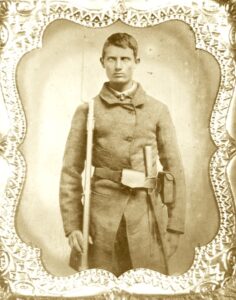
Private “Mage” Allen, Company H [Alabama Archives]
I’ve just completed a thorough scrub through the military and other records of the men of the 13th Alabama Infantry regiment, and extracted service and personal details for those who were present on the Maryland Campaign of September 1862.
Following is some interesting information that comes from that collection of data.
Some 1,250 men mustered into the regiment from its organization in Montgomery, AL in July 1861 to their surrender at Appomattox Court House in April 1865.
I found 371 of them were on the Campaign. See the regiment’s page on AotW for links to bio pages for each of those individuals.
– 358 were present in the battle at Turner’s Gap on South Mountain on 14 September 1862. The regiment was part of Colonel Alfred Colquitt’s Brigade, which fought Union General John Gibbon’s “Black Hat” Brigade that afternoon along the National Road leading to the gap.
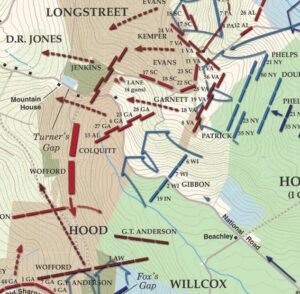
Turner’s Gap late afternoon 14 September 1862 [part of ABT map]
– 332 were in action at Sharpsburg on 17 September. They began the day fighting in and around the Miller Cornfield, and later in the morning those still standing helped defend the western end of the Sunken Road/Bloody Lane. The Regiment’s flag was captured by Private J. P. Murphy, Company K, 5th Ohio Infantry at Sharpsburg.
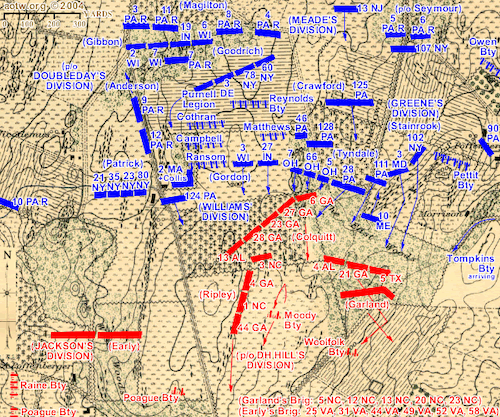
Sharpsburg battlefield on 17 September 1862 at 8:40am [interactive map]
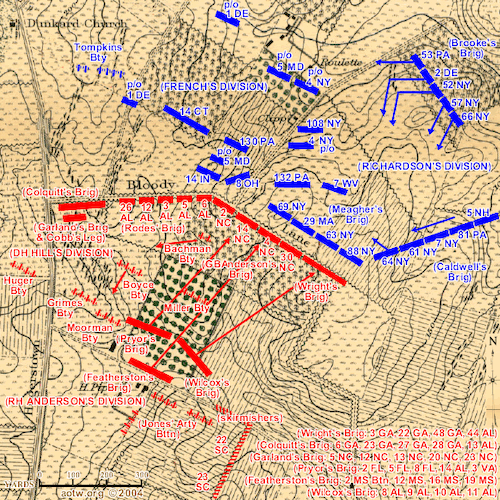
Sharpsburg battlefield on 17 September 1862 at 10:30am [interactive map]
Commanding Officers
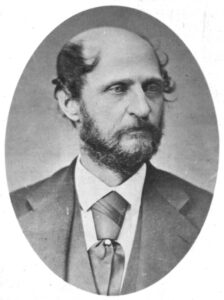
Colonel Birkett D Fry [Mollus/USAHEC]
The regiment – Colonel Birkett Davenport Fry (w)/Lieutenant Colonel William H. Betts, Jr. (w)/Captain Sidney Algernon Reaves (w)
[Major James C Aiken absent, wounded at Seven Pines, VA about 1 June 62]
Company A – recruited in Wilcox County – 2 officers and 15 men – 1st Lt. Stephen J Jones, commanding*
Company B – Montgomery, Macon, Chambers, Tallapoosa Counties – 3 officers, 23 men – 1st Lt. Hardy Valentine Gibson
Company C – Coosa, Tallapoosa Counties – 3 officers, 42 men – 1st Lt. Bailey Anderson Bowen
Company D – Randolph County [Randolph Mountaineers] – 3 officers, 41 men – Capt. Sidney Algernon Reaves (w)/1st Lt. Mark Wiley Kemp (pow)/?**
Company E – Randolph County [Randolph Rangers] – 4 officers, 39 men – Capt. Manoah Dixon Robison (w&pow)/1st Lt. John Dixon Howell Robison
Company F – Tallapoosa County [Tallassee Guards] – 40 men – 2nd Sgt. John L. Wilkerson (w)/3rd Sgt. John Hunter Thompson
Company G – Butler County – 1 officer, 38 men – Capt. Robert N. Cook
Company H – Coosa County – 43 men – 1st Sgt. Isaac Joseph Adams
Company I – Randolph County [Roanoke Invincibles] – 3 officers, 31 men – 1st Lt. Warren B. Andrews (k)/2nd Lt. Martin Wood
Company K – Randolph County [Stephens Guards] – 1 officer, 34 men – Capt. Elijah B. Smith
* Company A was detailed away from the regiment as part of an independent battalion commanded by Captain W.M. Arnold of the 6th Georgia, made up of the “A” companies of each of the 5 regiments of Colquitt’s Brigade: the battalion fought on the south flank of the brigade at Turner’s Gap on 14 September and in the East Woods at Sharpsburg on 17 September.
** by the end of the day at Sharpsburg on 17 September, Company D had no officers or sergeants present for duty; Corporals Howell & McClintock and 18 Privates remained.
Unit Demographics
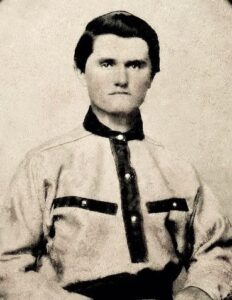
Private Harrison Sconyers, Company H [Chris Van Blargan]
The soldiers on the Campaign ranged in age from 16 – there were nine boys of that age present – to 54 years; the oldest being Capt Manoah D Robison of Company D.
Age distribution in Maryland in 1862
By residence at enlistment
130 Randolph County, AL
80 Coosa County
34 Tallapoosa County
30 Butler County
23 Montgomery County
18 Wilcox County
8 Chambers County
Small numbers each from Autaugua, Conecuh, Clay, Cleburne, Covington, Pickens, Barbour, Macon, Mobile, Pike, Sumter, Talladega, and Walker Counties in Alabama; neighboring Heralson, Carroll, and Fayette Counties in Georgia; one each from Sabine, TX, Columbia, SC, and Richmond, VA.
16 of unknown residence
By place of birth
179 in Alabama
144 in Georgia
18 in South Carolina
8 in North Carolina
4 in Virginia
4 in Mississippi
3 in Tennessee
5 in IRELAND
1 in ENGLAND
1 in CANADA
4 unknown birthplace
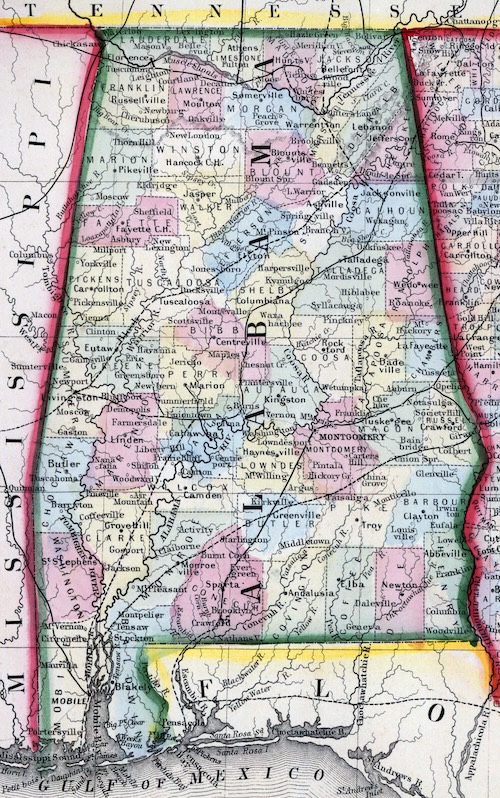
Alabama in 1860 [thanks to Dickinson]
By occupation
287 Farmers
9 Laborers
7 Students
6 Mechanics
5 each: Clerk, Overseer
4 each: Blacksmith, Factory worker, Merchant
3 each: Carpenter, Physician
2 each: Engineer, Lawyer, Painter, Teacher
One each: Barber, Bookkeeper, Bookseller, Butcher, Cabinet maker, Dentist, Hack driver, Mill manager, Minister, News publisher, Photographer, Printer, Saddler, Sailor, Tailor, Tanner
10 unknown occupation
Slaveholding
50 of these men (13%) were slaveowners or lived in a slaveholding household in 1860/61. For reference, 35% of Alabama families owned slaves in 1860. The 1860 Alabama population was 964,201 of whom 435,080 were slaves; 45% of the total.
At least for this regiment, this supports the adage that it was a “rich man’s war and a poor man’s fight” – slaveholders, generally wealthier, being underrepresented in the ranks of the 13th Alabama.
Family
There were 4 father-son pairs of soldiers together in Maryland:
Hezekiah & Benjamin Estes – both Privates in Company F
David (Private, Company G, 47th Alabama) & James Morgan – Private in Company K
Manoah & John Robison – Captain and First Lieutenant of Company D
William & Hugh York – both Privates in Company D
The fathers of 5 other soldiers were in the regiment at one time or another, but not with their sons in Maryland.
There were at least 29 sets of brothers present:
Adams (3 brothers), Adcock (3), Black, Burdette (3), Coe, Connaway, Dunlap, Edwards, Ford, Freeman (3), Gemes, Green, Gulledge, Hastie (3), Keller, Kent, Leach, Mitchell (3), Mitchum (3), Nichols, Owen (2 pairs), Reaves, Reeves (3), Savage, Speights, Spradlin (3), Wiggins, Williams
Many of these, and others, had additional brothers in the unit who were not in Maryland in 1862.
There were also other familial relations among these soldiers: uncles, nephews, and brothers-in-law. I have found this common in volunteer regiments of both armies where companies were recruited in small towns and rural areas where many of the residents were related by birth or marriage.
Recognition
General D.H. Hill, the Alabamians’ division commander, on the recommendation of Colonel Colquitt, mentioned 23 soldiers of the regiment by name in his after-action report. A high honor attesting to their bravery in action:
1st Lt. B.A. Bowen, Company C
2nd Lt. R.S. Tomme, Company E (wia)
3rd Lt. L. D. Ford, Company I
1st Sgt [M.G.] Herring, Company E (wia)
Sgt. J.L. Moore, Company A (wia)
[Corp.] Sgt. T.P.W. Bullard, Company F (promoted to Sergeant on the field)
1st Sgt. J.[I.] J. Adams, Company H
1st Corpl. J.A. Lee, Company E (wia)
Pvt. W.A. Estes, Company A (kia)
Pvt. J.S. Wingate, Company A (mwia/pow)
Pvt. W.S.[L.] Walker, Company A (kia)
Pvt. Isaac Hundley [Handly], Company A (wia)
Pvt. Thomas Sudler [Sadler], Company A (wia)
Pvt. J.J.[T.] Gordon [Jordan], Company A (mwia)
Pvt. Simeon Williamson, Company B
Pvt. Mosely McCall, Company C (mwia)
Pvt. J.M. Vanse [Vann], Company C
Pvt. [E.] J. Hutchings [Hutchins], Company F
Pvt. Thomas Argo, Company H
Pvt. J.S. Dennis, Company H (pow)
Pvt. W.J. Claybanks [Claybrook], Company H (wia)
Pvt. Joseph Herron [Herren], Company H
Pvt. W.D. Tingle, Company I
Survivors
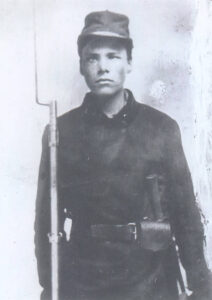
Private Rufus L Vinson, Company H [Alabama Archives]
Of the 371 men of the regiment who were there…
326 survived the Maryland Campaign
8 of them later became “Galvanized Yankees” – serving in Union units by the end of the war:
Pvt. David Bailey, Company C –> USS Saugus, US Navy
Pvt. James M Hammock, Company F –> Company G, First United States Volunteer Infantry
Pvt. Adolphus D Hearn, Company F –> Company H, First US Volunteer Infantry
Pvt. William G Martin, Company C –> Companies G & D, First Connecticut Cavalry
Pvt. John N Moore, Company D –> Company G, First Connecticut Cavalry
Pvt. Martin Van B Parish, Company K –> Ahl’s Battery, (1st) Delaware Heavy Artillery
Corp. Simeon Wilkie, Company F –> Company G, 3rd Maryland Cavalry
Pvt. Joseph J Yarbrough, Company E –> unknown unit
253 survived the war
39 surrendered with the regiment at Appomattox Court House in April 1865
Casualties in Maryland
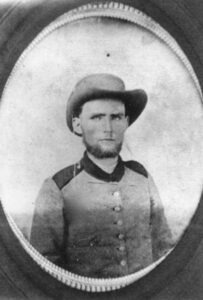
Private Joe Burns, Company D (kia) [Bob Atchison]
I have found no contemporary references which offer a count of the men of the regiment who were in Maryland or any accounting of their casualties.
In his definitive Maryland Campaign of September 1862 (ed. Clemens, Vol. 2, 2012) Ezra Carman noted “Our information from the 13th Alabama is that it had in action [at Sharpsburg] about 310 officers and men.” This tallies well with the number I found by name – 332. Concerning casualties, Carman only stated, probably specific to the action in and near the Cornfield at Sharpsburg, that they “lost a large percentage of their men.”
As a point of comparison, Scott Hartwig, in his I Dread the Thought of the Place (2023) used 300 as the strength of the regiment, based on Carman, and made an estimate of the total casualties in the regiment as 150 for Sharpsburg and Shepherdstown, extrapolating from the rate of losses in the 28th Georgia Infantry, who fought alongside the 13th Alabama. Again, a good estimate – I found 144 by name.
Summary of casualties for the campaign
31 Killed in Action
105 Wounded (14 mortally, 11 also captured)
32 Captured
168 Total – 45.4% of number present
Abbreviations: AWOL – absent without leave/deserter; KIA – killed in action; MWIA – mortally wounded in action (died of wounds); WIA – wounded in action (survived); POW – prisoner of war/captured
Casualties by company on the campaign
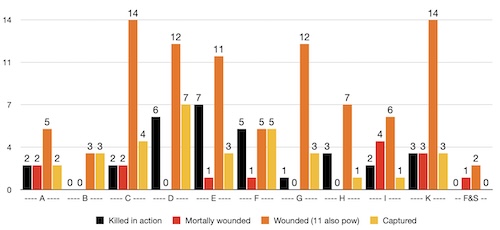
Losses by date
September, unknown place
1 POW – 2Lt W M Camp, Co. D; left behind ill
13 September, Middletown
2 POW
14 September, Turner’s Gap
1 AWOL – no later record
1 KIA
8 POW
3 WIA
15 September, Boonsboro
9 POW
16 September, Sharpsburg
1 Wounded – accidental gunshot
1 AWOL – “not heard from since”
17 September, Sharpsburg
4 AWOL – all returned later
30 KIA
14 MWIA
12 POW
87 WIA (11 of these also captured)
Aggregate casualties (less AWOL) for 16 and 17 September – 144 men
19 September, Shepherdstown, VA
1 AWOL – did not return, paroled in 1865
Note that although I don’t count men AWOL among the total casualties, in the 2 cases above where men were listed as absent without leave/deserters and not seen again, it is possible, even likely, that they were actually killed. Due to the uncertainty, I have not counted them with those killed in action.
About research sources
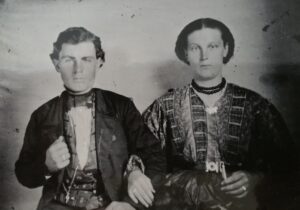
Private Jack Mickle, Company I, and wife Emily [FamilySearch/Margaret3130]
I used dozens of references to learn about these soldiers, but a few stand out as sources for nearly all of them. I commend them to you:
Central to my work were the soldiers’ Consolidated Service Records (CSRs) from the National Archives – I get mine online from the fold3 subscription service. My search for all the 13th Alabama men who were in Maryland in 1862 began there: I walked through each set of carded records for the regiment and extracted details of their enlistment and military service.
I bounced each name from the CSRs against the Alabama State Archives’ Civil War Service Database. These carded records are most useful where they indicate which battles a soldier was in and when they were absent. Other database information, however, like a soldier’s age, residence, name spelling, and service dates I found to be unreliable. Caveat emptor there.
For family and personal information, I most often use the Mormon genealogical database, online as FamilySearch. Perhaps obviously, any crowdsourced reference like this must be used carefully – errors abound – but I take care to only trust information backed by documents like the US Census, civil birth, death and wedding records, and the like. And in FamilySearch, most genealogical facts are linked directly to those sources for easy verification.
FamilySearch also hosts a number of other searchable collections I used, including the US Census schedules (1790-1950), Alabama Confederate Pension applications, the Alabama Veterans’ Census (1907, 1921, 1927), US Army Registers of Enlistment, and Applications for Government headstones – all in original page images, online.
For learning about the burial places of these veterans, there’s no better online reference than the Find-a-grave site. Again, not always perfect, but a massive collection of information about millions of people.
Here’s a spreadsheet all 371 of the men in the regiment and some basic facts about each, if you’d like to play with an extract of the data yourself.
As you should expect, there’s a page for each soldier on Antietam on the Web. Most have additional details about their lives before, during, and for the survivors, after the Campaign.
So there you have it.
Going through the records for this one regiment took the better part of three months, given real-life interruptions and other distractions along the way, so I may not be able to do this for many other units. But I’m sure I’ll do some.
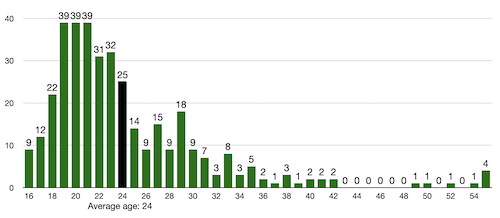

Please Leave a Reply